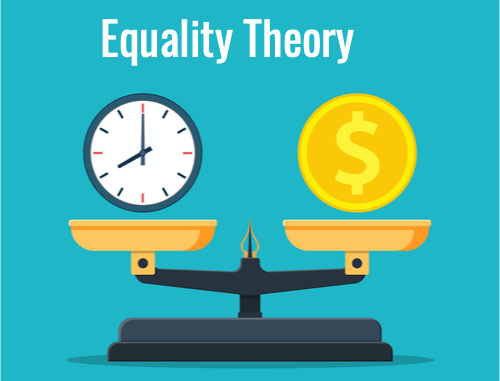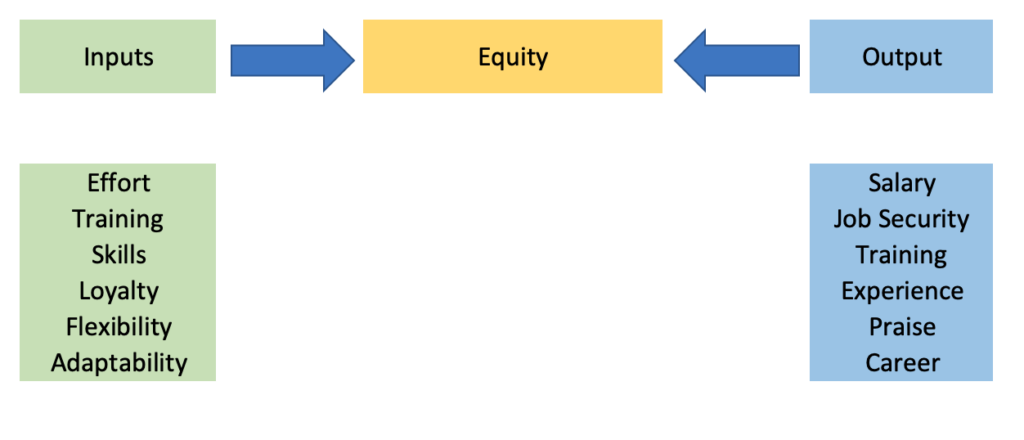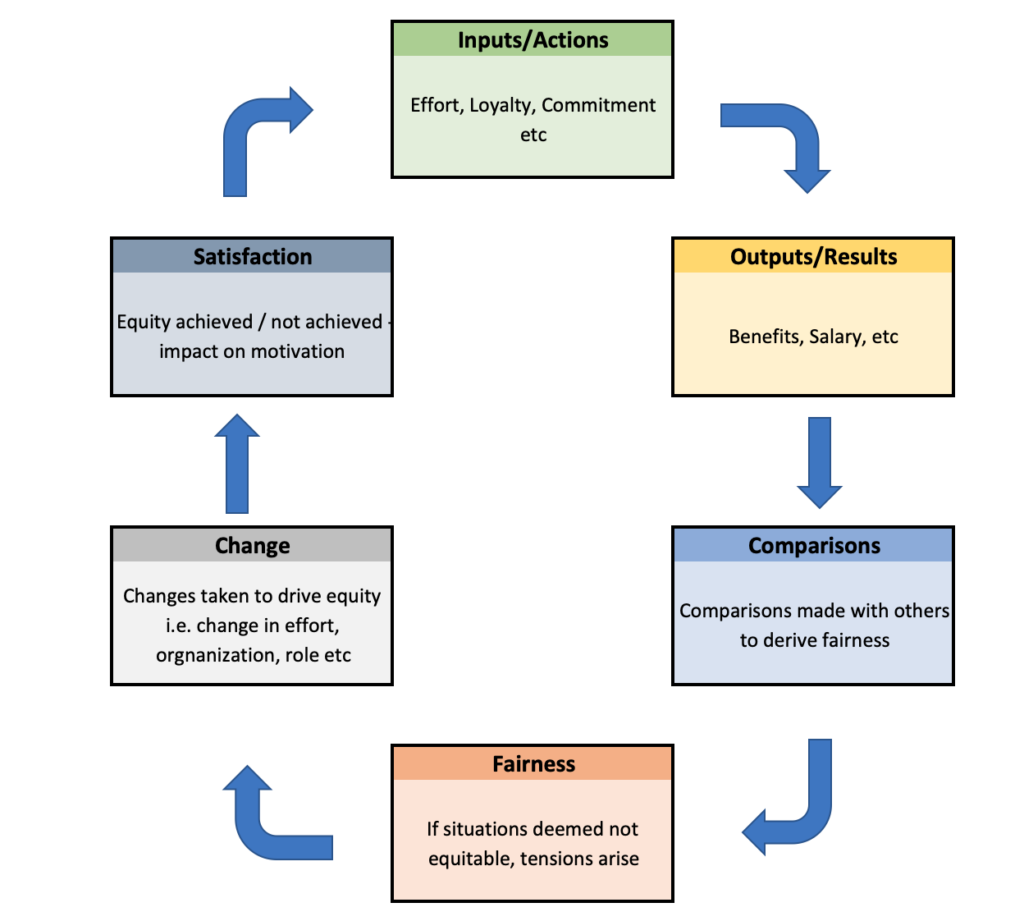
Adams Equity Theory examines the principle that for an individual to be motivated; they need to sense that the benefits they receive are:
- Reasonable in relation to their contribution
- Fair when compared to those obtained by peers.
The result is an equitable balance between inputs and outputs that drives motivation. If and when this alignment ceases, the theory argues, so does the motivation.
In today’s article, we’ll be looking at the detail behind John Stacey Adams Equity Theory of Motivation, looking at the connection between an individual’s contribution, feelings about their peers, and benefits received.
We’ll be covering
- What are the components of Equity Theory
- What are Inputs and outputs in Equity theory
- Employee Input (Contribution & Motivation)
- Outputs (Benefits or rewards)
- Fairness in Equity Theory
- Inequality in Equity Theory
- Further considerations in Equity Theory
- Individuals who perceive they are over compensated
- Individuals that feel under-compensated
- Equity Theory: Propositions
- Who is John Stacey Adams
- What Adams Equity Theory means for organizations
- What are the benefits of Equity Theory?
- What are the common criticisms of Equity Theory?
What are the Components of equity theory?
Adams Equity Theory explores the relationships between three factors
- Employee motivation
- Benefits received
- Perception of Fairness
We can examine this by way of an equation:
Input (contribution & motivation) = Output (reward) + Perception of Fairness
The fact that the model includes a perception of fairness within its formulae makes this a rather more complex model than by just studying the usual relationship between effort & pay.
As a result, the model stretches further than many similar models in that it examines not only the self but also incorporates the relationship with other people’s conditions.
The model looks to use these as a reference for an employee’s own position in determining fairness.
Another sophistication within the model is the move away from merely effort and reward.
Equity theory bases its understanding of inputs and outputs, where both can have a myriad of meanings.
These inputs and outputs aim to describe all aspects of what a person can provide and receive from their work.

What are the inputs and outputs in Equity theory?
To further understand this, we need to examine what we mean by inputs and outputs.
Employee Input (Contribution & Motivation)
Inputs are those contributions that help towards a goal.
They are typically aligned with something that an organization wants to achieve; for example, they may want:
- 100 widgets manufactured,
- A design to be released
- 15 customer calls processed
As a simple example, we can consider a factory worker who contributes to an organizational goal (sales) by helping in the manufacturing process).
When we look at the contributions of that employee a little more closely, there can be a number of things that an individual does to help towards an organizational goal (not just manufacture the widget). These can be things like:
- Effort
- Training
- Providing skills learned through experience
- Loyalty
- Being adaptable or flexible
- Following direction
- Collaboration with team members
These are all examples of things that can contribute to targets.
Outputs (Benefits or rewards)
In return for these contributions, an individual receives something back from the organization.
In a basic model, the first thing that springs to mind is the remuneration, what they’re paid for being employed, but that is not the only benefit that is typically received.
Other benefits might be:
- Holiday entitlement
- Job security
- Training benefits
- Experience
- Personal development
- Praise / recognition
- Career progression
Fundamentally receiving something that offers an advantage to their life or career can be seen as a positive benefit.
Fairness in Equity Theory
The third aspect of Adams Equity Theory of Motivation is the concept of fairness.
“Fairness insinuates a level of comparison with others.”
We can class fairness in several ways:
a/ Comparing benefits outside our organization
For example, we can look at:
- Norms within society
- Norms within industry
b) Comparing benefits with peers.
While there may be difficulties in making direct comparisons (due to lack of information), perception is everything.
Individuals may rely on estimates, anecdotes, perception, gossip, etc.
Through both of these criteria, we can assess fairness and assume the levels of motivation generated.
Inequality in Equity Theory
When inputs and outputs are not balanced, and equality with peers is not evident, then the situation can be assessed as unfair.
Where this environment exists, demotivation can occur.
So we can describe the cyclical nature of fairness and motivation by using a diagram such as the one below.

Further considerations
1/ Individuals who perceive they are over compensated
Where there is a perception by individuals that they are overcompensated, they may react in several ways to this situation; they may:
- Perceive guilt
- Increase effort
- Change perceptions (i.e., perception of the values of inputs/outputs)
2/ Individuals that feel under-compensated
Individuals that feel under-compensated may:
- Feel injustices
- May try to address levels of benefits (quit organization)
- Reduce efforts
3/ Equity Theory: Propositions
Outcomes of Equity theory can be equated to four positions:
a) Self-inside – Individuals seek to maximize their outcomes
b) Self-outside – Groups look to maximize mutual rewards by utilizing practices for distributing rewards and costs between members of a group in an equitably way.
c) Others-inside – Inequitable relationships drive distress. The greater the difference, the greater the distress. Distress can occur at both ends (i.e., the person receiving the greater reward and the person who receives the lesser value.
d) Other-outside
Individuals who perceive inequality, endeavor to reduce anguish by attempting to restore equity. This is on a sliding scale, i.e., the greater the inequality, the greater the drive to deliver equity.
Who is John Stacey Adams
The Equity theory was developed by John Stacey Adams in 1963. He was a behavioral psychologist; you can find out more about him here
What Adams Equity Theory means for organizations
In broad terms, the model drives organizations to consider the benefits being offered to employees in relation to motivating them.
The other key aspect the model promotes is that of fairness within their organization and how this can affect important aspects such as
- Staff retention
- Productivity
- Recruitment
The model offers a view for those in leadership positions in that
- Fairness should be a target of leadership
- Relationships contribute towards output
- Perceptions of staff are important
- Contributions vs. inputs are important
What are the benefits of Equity Theory?
Some of the key benefits that Equity Theory provides are:
- Provides further insight into why pay & conditions are not the only drivers of motivation
- It helps us understand how others can strongly influence motivation through perception and information
- Provides an understanding of how motivation can change based on surroundings (and perception of fairness).
- It helps us understand potential demotivating factors.
What are the common criticisms of Equity Theory?
Some common criticisms of Equity Theory include:
- It makes an assumption that levels of demotivation are equivalent to the levels of unfairness, which may not be the case.
- The model is overly simplistic and ignores a number of other contributory factors (i.e., age/ demographics).
- The model examines fairness within a situation but ignores whether the overall situation is fair (i.e., parity between organizations).
Summary
Equity Theory helps provide a method of appreciating how outputs can be influenced by numerous factors (inputs) and perceived fairness.
It explains how equality can be a motivational factor. It suggests to us that the perception of how one is treated can be a crucial factor in motivation, which in turn can help influence management tactics.
We’d love your feedback; you can reach out to us on Twitter or utilize the feedback below this article.
What do you think of Equity Theory? Does your organization utilize it within its Human Resources processes? If so, what tips/tricks do you have to make it successful?
This article is part of our Human Resources Guide.